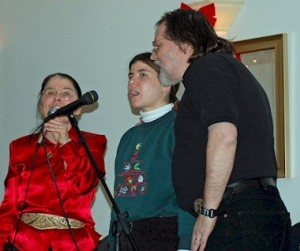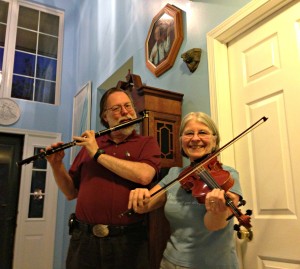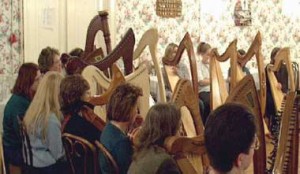
Kathy, Emma and Dennis harmonize at a recent Christmas Wren party.
You’ll have a hard time finding two busier traditional Irish musicians than Kathy DeAngelo and Dennis Gormley.
Together, they perform as the trad duo McDermott’s Handy (named after the County Leitrim, and later Monmouth County, N.J., fiddler Ed McDermott). And they preside over a popular traditional Irish music session Thursday nights at Three Beans Coffeehouse in Haddonfield, N.J. With Mermaid Inn session leader Chris Brennan Hagy, they also moderate the Next Generation youth Irish music group.
With bodhran in hand, I’ve accompanied them in a few performances and a few more sessions. Turnabout being fair play, Dennis accompanied me on flute when I took a shot at Comhaltas Ceoltóirí Éireann’s Mid-Atlantic Fleadh Cheoil a couple of years back. I also took whistle lessons from Dennis—none of which quite “took,” through no fault of Dennis’s. (Apparently, you have to practice.)
Both talented multi-instrumentalists, Kathy and Dennis have been part of the Delaware Valley Irish music scene for decades. They’re as generous with their time and knowledge as they are talented.
As well as I think I know them, there’s still lots more I don’t know, So I posed a few questions.
Q. How did you two get together, personally and musically? And how big a role did the music play?
Kathy: We met at the Rutgers Saturday Folk Festival in July 1973 when Dennis was playing bass with Saul Broudy, and practically every other performer. I managed to “persuade,” in my own charming fashion, the festival organizer to let me perform with my band in a brief slot that afternoon using the argument that he didn’t have one single woman performing that day. Trouble was, the bass player in my band hadn’t lugged his bass to the student center, whereas all the guys had brought their guitars. So I very boldly approached Dennis and asked if we could borrow his bass. He was too nice, and I was too cute, for him to tell me to buzz off—and I’ll let him get a word in edgewise here.
Dennis: “Cute” is an understatement. I was stunned by her heart-stopping beauty and amazing talent. She could have asked me sign over all my worldly assets and I would would have used my own pen.
Anyway, I was up playing bass for Philadelphia folk music icon Saul Broudy. Saul was working in D.C. at the Smithsonian
Folk Life Festival and traveling up to New Brunswick by train. I drove up early to catch the music at the festival. Little did I know …
Kathy: So we started off playing everything but Irish music at the beginning. We played country music, bluegrass, swing, old-time and good old American folk songs. I was playing Irish music with Ed McDermott, my mentor, but that was a separate world.
Q. You both play multiple instruments First of all, thanks for making me realize just how much I have to learn, but, second, can you tell me how and when you learned those instruments, and how gravitated toward Irish traditional music?
Kathy: I started playing guitar in the 7th grade after being allowed to give up the accordion. My father thought every Italian girl should learn the accordion but in 1965 no right-minded teenager wanted to play the accordion. Everybody in my family played or sang. I just played chords and followed charts on pop music sheet music my brother bought. I got into folk music and by the time I got to college I opened the Mine Street coffeehouse in New Brunswick and got in with a whole crowd of people who played all kinds of music and went to folk festivals. The guys in my band thought I would look good playing a banjo so they gave me one for my birthday. My dad gave me his old mandolin. Other instruments followed and I had the time to learn them.
Two of the instruments I’m most associated with now, harp and fiddle, I didn’t take up till relatively late in life. I started teaching myself fiddle after Ed McDermott died in 1977—and I regret I didn’t take it up while he was living. I played guitar with him for years and he was the one that got me started down the path of the Irish dance music. Besides backing him up, I was flat-picking the tunes. When I moved to this area after Ed died I only knew two people down here and Dennis was one of them. I had a few Irish gigs and I asked him to play with me. He said “I don’t know anything about Irish music.” He insisted on coming over to learn a few tunes before this gig and I was amazed that he’d sit there and write the tunes down while I played them. Well, you know how one thing leads to another. Skip ahead to 1979 and Dennis and I get married. In 1984 I came home from work and Dennis had bought me a harp, which were hard to come by in those days. He had already worked out how to play “If I Only Had a Brain” so I figured I had to get to work to put some Irish music on it!
Dennis: The writing tunes down bit was always a way for me to learn and memorize the tunes.To this day, I’ll write down a tune I’m want to learn (see http://www.hslc.org/~gormley/tunes/giftunes.html), then very rarely refer back to the manuscript.
I started the obligitory piano lessons at about age 6 or 7. My father had rescued a piano from a bar; I remember it had the cartoon character Snuffy Smith on it. But once we learned to read, it got a new coat of paint; apparently, Snuffy was saying some rude things! One day, my parents heard mepicking out the melody for the “William Tell Overture” (you would know it as the theme from the Lone Ranger), and decided to send me for lessons. I never got as good as I probably could have, because I always wanted to learn by ear, and the teachers had this annoying habit of wanting me to read the music.
Anyway, my father Joe Gormley played the guitar as well, in a Freddie Green Big Band style of guitar. Apparently in his younger days he was a touring musician for a short while, which probably led to his advice, “Music is the best part-time job in the world.” My mother told a story of having to wire him money one time so he could get home, but I was never able to get any other details out of them. Up until the time he passed away, he was performing on a regular basis.
So when 1964 came around, there was already an electric guitar around the house. Of course, when I started playing it, I got a nylon-string classical guitar as a birthday present. I think there were thoughts of a classical guitarist in the family, but I immediately recognized it as the same sound heard on the Beatles “And I Love Her.”
I took up string bass in high school, coupling that with bass guitar in high school rock groups. Again, my father counseled, “There are thousands of guitar players, but not many good bass players.” Inspired by my high school band and orchestra director, James Maxwell, I went to Glassboro State College as a music education major and was exposed to all the instruments typically found in a school music program; for the purposes of this narrative, this is pretty much where I first picked up a violin and flute.
Fast forward to the early ‘70s and the folk music of the social activists. I missed the Kingston Trio folk music boom, but Peter Paul and Mary, Buffy St. Marie, Arlo Guthrie, and others were heard in my home. I was playing acoustic guitar and string bass, and working teaching folk music at the now-defunct Haddonfield Music House, giving lessons on guitar, bass, dulcimer, mandolin; they pretty much pushed any student wanting to learn folk music to me, whether I knew the instrument or not!
I started attending meetings of the Philadelphia Folk Song Society, where I met up with several musicians whom I performed with over the years, including Caryl P. Weiss and Saul Broudy. Through Saul, I got the opportunity to perform with many revivalist performers such as Winnie Winston, Steve Goodman, Vasser Clements, and John Prine.
So, toward the mid- and late ‘70s I was playing and performing folk music and traveling to venues throughout the Northeast and up into Canada. Attending and performing at folk festivals, I heard a great deal of Irish music, notably at the Philadelphia Folk Festival, where Kenny Goldstein regularly programmed and hosted a “Celtic Ceilidh” (Sunday afternoon at the Tank Stage). It was “hip” in the circles I traveled and performed in to deride the “diddly diddly,” but I was always drawn to it. Even though there was no Irish music played in my house, perhaps it was a sort of racial memory calling to me.
When I first started performing with Kathy, a short time after the death of Ed McDermott, I figured the mandolin, tuned like a fiddle, would be the most appropriate instrument I had to play the dance tunes. But I never really had the technical expertise to play tunes up to speed. Casting around, I picked up a tin whistle and worked on that, then much later (after a single but memorable lesson with Seamus Egan when he told me he was moving to New York to work with this new group), got a simple system wooden flute and started working on it. Still can’t get the notes for “Nights in White Satin” on it, though.
Like Kathy, I often wonder what it would have been like to be playing flute when Ed McDermott was still alive.
Q. How long have you been anchoring Three Beans?
Kathy: We started doing the session at the Three Beans not long after it opened in 1995, but the session actually started in a back room at the former Katie O’Brien’s, a restaurant in Haddon Township in 1992, I think. When the Three Beans expanded into the shop next door, there was room for us.
Dennis: My sister Lorraine Gormley had met a guitarist and singer from Kerry named Richard Browne, who told her of a session he was running at Katie O’Brien’s. With (daughter) Emma being an infant, it was easy to put her to bed and then get out to the session. (Oh, did I mention my mother was living with us then? Get of my back, DYFSS!) So we started going out. Eventually, having the session at Katie’s became untenable, with a trad session being low on their list of priorities. Harp and Dulcimer maker Dave Field was living in Haddonfield at the time, and he found the Three Bean location.
Q. How did McDermott’s Handy develop?
Kathy: I was the first music director at the New Jersey Folk Festival and Ed McDermott was one of our featured performers at the first festival in 1975, and then again in 1976. Everybody loved him. Here was this 80-year old fiddler who played with incredible energy with the college students who came to learn from him.
He died on New Years Day, 1977, and the festival asked me to put together a tribute to him for the 1977 festival. I asked a whole bunch of players from around the state who had learned tunes from Ed for years to come and play. It was a great night. I used the name McDermott’s Handy, after a track from Gordon Bok’s record of tunes he learned from Ed. So I just decided to keep it going. After that, it was mostly Dennis and me with an ever-changing roster of other musicians until 1984, when it was just the two of us. Now our daughter Emma, who plays fiddle and also sings, sits in with us occasionally.
Dennis: Aside from recordings and touring groups, Ed McDermott was the first practitioner of Irish music that I had met. His dedication to the music and patience in teaching what he had to a gaggle of young musicians with scant background in the music, was an inspiration. The opportunity to commemorate his contribution to Irish music is a continuation honor.
Q. I understand some fella named Seamus Egan once opened for McDermott’s Handy. When and where was that, about how old was he, and did you have an inkling of what a dynamic musical force he was going to turn out to be?
Kathy: Actually, it was the Egan family that opened for us at the old Perimeter coffeehouse in Collingswood, maybe that was in 1985 or so—Seamus and his sisters Siobhan and Rory. They were pretty young—not old enough to drive themselves there, I don’t think. There was lots of talent in them and passion for the music. They were awesome players even then. In fact, I arranged for them to play at the New Brunswick coffeehouse and have photos of all three of them on that stage.
Q. Your daughter Emma plays fiddle with you. Lots of kids might go off in a different direction–say, sports, or, musically, playing anything but the same music mom and dad play. How did that happen, and how did she get to be so good? (And to be such a sweet kid?)
Kathy: Emma has been listening to this music since before she was born. She was only 6 weeks old in the carriage parked stage left when we played at Bethlehem Musikfest in 1987. I’d practice the harp with this little baby laying on the floor at the foot of the harp so I could keep an eye on her. She loves it. She was about 2 years old when she started sing-songing melodies, in pitch. When it was feasible, we brought her to a lot of our concerts so it was not surprising to us that, when she was offered a chance to learn a musical instrument at school, she chose the violin. She’s got an encyclopedic knowledge of tunes. And she’s a big part of the reason why Dennis and I wanted to get those young musician sessions going.
Dennis: During one performance St. Patrick’s Day in 1987, Kathy was playing the bodhran; in utero, Emma started kicking back. So you could say she’s been PLAYING before she was born. Even today, when she goes up to her room, you can hear Irish songs and tunes wafting down from her CD player.
Q. What is there about this music that keeps you coming? You’re obviously both very passionate about what you do.
Kathy: I just love the infinite variety of this music, it’s simple and yet complex at the same time. There isn’t a day that goes by that I don’t think of the influence of that one man, Ed McDermott, and how knowing him shaped the course of my life. It’s a good part of what motivates me as a teacher to help pass this music along. I’m blessed to be able to sit down with wonderful players, like Dennis, all the time who keep that fire lit for me.
Dennis: I see all of us who play this wonderful music as links in a chain, that stretch back a long way. I was explaining to ZB Cummins, a 13-year-old whistle student: Kathy and I learned our first tunes from Ed McDermott, who came to this country in 1915, and was born at the end of the 19th century. He first got his music from his father, who would have been born in the mid-1800s. Now, there are people who get their first tunes from me or Kathy, and who will hopefully will pass them on as well.



